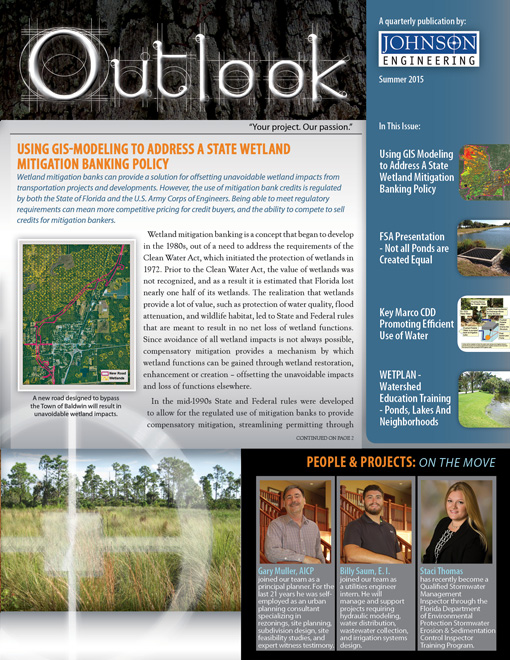 Wetland mitigation banking is a concept that began to develop in the 1980s, out of a need to address the requirements of the Clean Water Act, which initiated the protection of wetlands in 1972. Prior to the Clean Water Act, the value of wetlands was not recognized, and as a result it is estimated that Florida lost nearly one half of its wetlands. The realization that wetlands provide a lot of value, such as protection of water quality, flood attenuation, and wildlife habitat, led to State and Federal rules that are meant to result in no net loss of wetland functions. Since avoidance of all wetland impacts is not always possible, compensatory mitigation provides a mechanism by which wetland functions can be gained through wetland restoration, enhancement or creation – offsetting the unavoidable impacts and loss of functions elsewhere.
Wetland mitigation banking is a concept that began to develop in the 1980s, out of a need to address the requirements of the Clean Water Act, which initiated the protection of wetlands in 1972. Prior to the Clean Water Act, the value of wetlands was not recognized, and as a result it is estimated that Florida lost nearly one half of its wetlands. The realization that wetlands provide a lot of value, such as protection of water quality, flood attenuation, and wildlife habitat, led to State and Federal rules that are meant to result in no net loss of wetland functions. Since avoidance of all wetland impacts is not always possible, compensatory mitigation provides a mechanism by which wetland functions can be gained through wetland restoration, enhancement or creation – offsetting the unavoidable impacts and loss of functions elsewhere.
In the mid-1990s State and Federal rules were developed to allow for the regulated use of mitigation banks to provide compensatory mitigation, streamlining permitting through the use of existing mitigation credits. The use of mitigation banks is now typically encouraged and favored over onsite mitigation because the banks provide a mechanism for protecting regionally significant wetlands. Florida now has over 80 mitigation banks – each with a permitted geographical service area within which their wetland credits may be used to offset impacts. The intention behind service areas is to ensure that the functions lost from a particular area will be offset by mitigation within the same region, these service areas are typically based on watershed boundaries and other ecological considerations.
The State of Florida also regulates mitigation banks on a smaller scale based on drainage basins, or subdivisions of watersheds, there are around 90 drainage basins in Florida. Most mitigation bank service areas cover several drainage basins. However, when proposing to use mitigation credits generated in a separate drainage basin from where the impacts will occur (even when the impacts are within the mitigation bank service area) the State requires that applicants demonstrate that the mitigation will not result in “unacceptable cumulative impacts” within the drainage basin. This rule is meant to provide further assurance that wetland mitigation will not result in the loss of critical functions within these smaller geographic areas, and as the rule states will not result in the “proverbial straw that breaks the camel’s back” regarding water quality or wetland functions in the basin.
The state rule provides minimal guidance as to how an applicant can demonstrate that a mitigation plan will not result in unacceptable cumulative impacts. Dependent on the project location and type, it is up to the reviewers of one of the state regulatory agencies – either one of the Water Management Districts or the Department of Environmental Protection – to determine if the requirements of the rule have been met. To date the agencies do not have a consistent approach to making this determination. The Johnson Engineering environmental group has successfully worked in cooperation with two of these agencies, the South Florida Water Management District and the St. Johns River Water Management District, to develop Geographic Information Systems (GIS) models that along with other analyses have been used to meet the regulatory requirements. The GIS models were developed to provide a quantitative, non-biased, repeatable method of valuing wetland functions for the entire drainage basin where the project impacts will occur. The model uses an array of publicly available data to quantify wetland functions associated with five factors that the state rule requires to be considered. The model is run to evaluate baseline conditions, and then to evaluate future conditions assuming mitigation occurs out of basin for the proposed project and future like impacts. The final report submitted to the water management district clearly addresses every component of the state rule, providing the permit reviewers the data needed to support a decision to allow out of basin mitigation.
The use of this methodology most recently provided the assurance needed by the St. Johns River Water Management District to allow for the sale of credits from Longleaf Mitigation Bank for a large Florida Department of Environmental Protection (FDOT) project. Without this assurance the FDOT would have been required to buy credits from the one bank that is located within the drainage basin. The competitive bidding process between the banks resulted in a significant cost savings to the FDOT of $1,750,000.
The Johnson Engineering environmental group is passionate about using the best available science and data to help our clients meet regulatory requirements, and to provide regulators with the information they need to make informed decisions.
For more information, contact Jaime Boswell at [email protected].































































